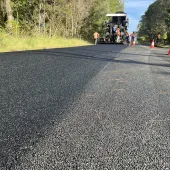M25 reaches Major Milestone

First published in the January 2017 issue of Quarry Management
Shell’s modified bitumen solutions help London’s iconic outer ring road reach its 30th birthday
The M25, as much a feature of the capital as Wembley’s arch, the London Eye or Tower Bridge, has reached the milestone of being operational for 30 years. Officially opened by Margaret Thatcher on 29 October 1986, the 117-mile stretch of road has catered for the needs of millions of commuters, holidaymakers and hauliers for three decades.
Spanning five counties – Kent, Surrey, Buckinghamshire, Hertfordshire and Essex – and encircling all of Greater London (with the exception of North Ockendon), it is Europe’s second-longest orbital road, coming in behind only the Berliner Ring, which is 122 miles long.
The motorway, as integral to the lives of millions of Britons as smartphones, HD television and internet shopping, and arguably as revolutionary as the UK’s rail network and the London Underground, has now been open for more than 11,000 consecutive days, and has for the vast majority of that time been required to cope with around twice the number of vehicles it was initially designed to deal with.
Each day approximately 150,000 vehicles venture on to the M25, a number that far exceeds the 88,000 vehicles it was intended to tolerate when the road first opened. On particularly busy days the number of vehicles on the motorway has been known to swell to around 200,000 – almost two-and-a-half times more than its original capacity.
Shell’s involvement
During its construction – which began in 1975 – more than 2 million tonnes of concrete and 3.5 million tonnes of asphalt were required to create the motorway. However, because the M25 has been in constant use for almost a third of a century, and owing to the fact that the number of vehicles using the road has increased dramatically since it was opened, maintenance has been a constant necessity.
David Whiteoak, former technical manager for Shell UK, spent much of his career working to develop modified bitumen solutions that would prolong the life not only of the M25, but numerous other roads around the UK.
He said: ‘The M25 is carrying far more vehicles than it was initially designed to cope with. While that’s the case for most roads in the UK, it is especially true of the M25. And, because of this increased demand, Shell are constantly seeking to create advanced products that will keep roads in good condition.
‘I remember one project that we carried out on the M25 with particular clarity. It was during the late 1990s, and there was some maintenance work being carried out on Reigate Hill, which is a relatively steep section of road. The bitumen that was initially put down deteriorated rapidly – I’d say within a matter of weeks. Because this section of the motorway has a lot of HGV traffic travelling at low speed, the surface has to be incredibly robust or there will be a lot of damage and deformation.
‘The solution was to re-surface the road with a polymer-modified bitumen called Shell Cariphalte DM, a product developed by Shell specifically to improve the resilience of roads that are put under immense strain. This was an immediate success.
‘This is just one example of Shell’s ongoing work to keep Britain moving. Maintaining and improving Britain’s roads may appear to be quite a straightforward task, but there is an incredible amount of intelligent work that goes into creating solutions that will stand the test of time.’
In popular culture
The M25 has provided inspiration for a number of authors, including Terry Pratchett, Neil Gaiman, and, perhaps most notably, Iain Sinclair, whose book London Orbital was written following a year-long journey around the M25 on foot. Not only has the road stimulated the creative minds of a number of authors, but dance duo Orbital, who shot to prominence in the 1990s, have credited the road as the inspiration behind their group’s name.
Did you know?
The M25 is the both the UK’s busiest and most recognizable motorway, but did you know:
- The northern part of the M25 follows the route of the Outer London Defence Ring, set up at the beginning of World War II.
- A ring road around London was first proposed in 1905 so that journeys by horse and cart would be subject to fewer delays.
- It would take approximately 1h 40min to circumnavigate the M25 while travelling at the national speed limit.
- Subscribe to Quarry Management, the monthly journal for the mineral products industry, to read articles before they appear on Agg-Net.com








